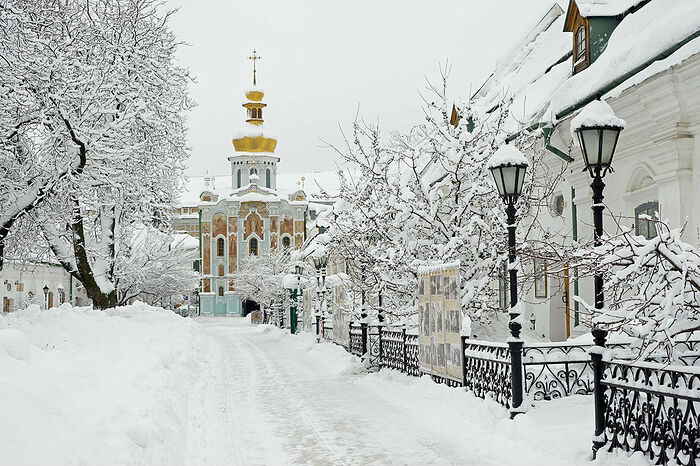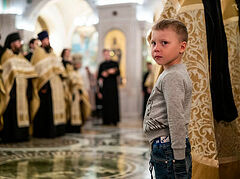I always look forward to the Nativity Fast with great joy
For me autumn is in some sense a period of relaxation and rest, something like a vacation. Even in the liturgical sense, as clergymen we live—spiritually, mentally, emotionally and physically—in the liturgical cycle: daily, weekly and yearly. This is what life is made of; we celebrate the Vespers, the Liturgy, live until Sunday or some great feast and meet it worthily at the altar of God, offering the Bloodless Sacrifice. This is basically the life of any priest and it does not change in the autumn.
And suddenly November 28 comes—the beginning of the Nativity Fast. It is also called Phillip’s Fast, because it is preceded by the feast of the holy Apostle Philip on November 27.
And now your life is focused: it is concentrated on the distance, like a runner or a rock climber. You live to reach the top. And this peak is the Nativity of Christ—the Birth of God, the Birth of the Savior of the world. God personally comes down to earth for you in order to personally lift you to Heaven.
Clearly, you need to fast both spiritually and physically. As it is said in the Holy Gospel: But thou, when thou fastest, anoint thine head, and wash thy face; That thou appear not unto men to fast, but unto thy Father which is in secret: and thy Father, which seeth in secret, shall reward thee openly (Mt. 6:17-18). To “anoint thine head” means to call upon your soul the grace of God, making it a temple of the Holy Spirit by participating in the sacraments of the Church, especially in confession, in Communion of the Body and Blood of Christ, and in the Divine Liturgy. To “wash thy face” means to physically cleanse your body by abstaining from animal products so that your body can become a suitable and faithful worker for the soul in attaining the Kingdom of Heaven. Moreover, the Nativity Fast is not strict. We are allowed to eat fish and other seafood except for Wednesdays and Fridays, when for the sake of the Passion of Christ we abstain from fish and switch to only plant-based food and fast more strictly. Now our Church publishes fasting calendars for each day of the fast. There are also similar calendars on Orthodox websites. And there you can see what and when you are allowed to eat.
But the most important thing is not just ritual abstinence from certain kinds of food (although this is important, too). What matters first of all is the vector, the direction of the movement of your life towards the radiant feast of the Nativity of Christ.
And the first great feast that we celebrate at the very beginning of the Nativity Fast is the Entry of the Most Holy Theotokos into the Temple. The Mother of God Herself invites us together with Her to ascend day by day, as though up the steps of the Temple of Jerusalem, into the Church, as into Heaven, where the Lord is waiting for us with His open welcoming arms.
And later in the fast there is such an abundance of feasts of the saints. They are like diamond stars burning in the skies and forming a kind of mysterious route map, along which we will definitely reach our Beloved Lord Jesus Christ!
These are the feasts of the holy Right-Believing Prince Alexander Nevsky (December 6), Great-Martyr Catherine (December 7), the Apostle Andrew the First-Called (December 13), Great-Martyr Barbara (December 17), St. Sabbas the Sanctified (December 18), Holy Hierarch Nicholas the Wonderworker (December 19) and many other saints of God.
On the two Sundays before the Nativity of Christ (those of the Holy Forefathers and the Holy Fathers), we somehow become one with the whole humanity, led by the holy ancestors Adam and Eve and other righteous people, and freeze, as if at the Six Psalms in the mysterious darkness and silence of the nascent great dawn of the Nativity of Christ, waiting for the “Sun of Righteousness” to rise over the world, as is sung in the troparion of the aforementioned feast.
“Thy Nativity, O Christ our God, shined the light of knowledge upon the world: for thereby those who adored the stars were taught by a star to worship Thee, the Sun of righteousness, and to know Thee, the Dayspring from on high: O Lord, glory be to Thee.”
And therefore, from January 1 and 2 we intensify our fasting. During these remaining few days before the Nativity of Christ we fast as during Great Lent—we eat only plant-based foods. On Christmas Eve, fasting is a little intensified. At first, we eat “kolivo”, or “sochivo”, hence the name of the day in Russian (Sochelnik). This is boiled wheat (rice) with honey and other sweet things. Wheat here is a symbol of life—the Nativity and the Resurrection of Christ, and the spiritual Nativity and Resurrection in Christ of all of us. Honey is a symbol of a sweet blissful life in Paradise, which, God permitting, is ahead of us. Any other vegetable foods are also eaten with oil. You can have a meal after the dismissal of the Liturgy of St. Basil the Great, united with the Royal Hours and Vespers. And, of course, you should break your fast after the dismissal of the Liturgy on the very feast of the Nativity of Christ—January 7.
The most important thing for us is to have if only a particle of that great humility and that great love for God that the Most Holy Theotokos had; of that great desire to serve the Lord with our lives, which the Righteous Joseph the Betrothed and his son James had; of that thirst for Divine wisdom, which the Magi who brought gifts to the God-Child Christ had; and of that holy simplicity of soul which the shepherds had so that we, like the Angels singing “glory to God in the highest, and on earth peace, good will towards men!”, can become conductors of the Divine light.
The holy Apostle Paul wrote: Brethren, I count not myself to have apprehended: but this one thing I do, forgetting those things which are behind, and reaching forth unto those things which are before, I press toward the mark for the prize of the high calling of God in Christ Jesus (Phil. 3:13-14).
“Forgetting those things which are behind” means leaving our sins and passions like crumpled and destroyed garbage; and “reaching forth” means rushing like a hound, flying like a swift falcon to reach and kneel in your heart before the greatest miracle of miracles—God Who lies in the flesh as a Babe in a manger for our salvation! This is really the goal of all goals, and the meaning of all meanings.
With all my heart I wish us, dear brothers and sisters, to reach the radiant feast of the Nativity of Christ in order to enter into its most radiant and immense joy of the triumph of God, Who deigned to become a Man, and thus united with all of us!




